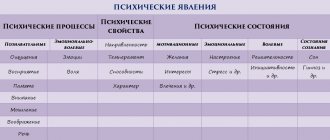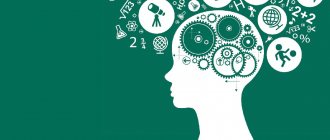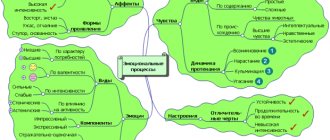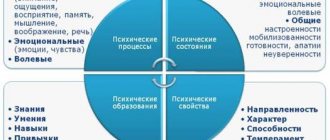“Psychological processes, states, properties”
Introduction
The relevance of the topic is determined by the need for modern people to have scientific knowledge about the human psyche. Such knowledge helps in solving problems both in everyday life and in professional activities.
The whole variety of mental phenomena in psychology is quite conventionally divided into mental processes, mental states and mental properties. All these forms of mental phenomena are closely related to each other, they are not something independent and isolated, and their isolation is determined by the methodological need to make it more convenient to study such a complex object as human mental life. Thus, the identified categories represent the structure of knowledge about the psyche rather than the structure of the psyche itself. At the same time, many researchers focus on the systematicity, integrity and indivisibility of the psyche as its fundamental property [4, p. 256].
The mental functional system in action is a mental process
. Let's consider the basic mental processes most often highlighted by the authors of textbooks and manuals on psychology.
Psychological processes are inherent in every person. Mental processes: sensations, perception, attention, imagination, memory, thinking and speech. They are basic components of human activity.
Psychological processes are not just involved in activity, but they develop in it. All mental processes are interconnected and represent a single whole. In the absence of any of the mental processes (speech, thinking, etc.), a person becomes inferior. Activity shapes mental processes. Any activity is a combination of internal and external behavioral actions and operations. We will consider each type of mental activity separately [2, p. 238].
Purpose of the study: to study the basic psychological processes, states, properties.
Research objectives:
— study pedagogical and methodological literature on the research problem;
- select and systematize the material.
1. Basic psychological processes, states and properties.
All mental processes can be divided into two main groups.
Specific, or actually cognitive, processes, which are sensation, perception and thinking. The result of these processes is the subject’s knowledge about the world and about himself, obtained either through the senses or rationally:
- sensation is the identification of the properties of an object, sensory, sensuality;
- perception is the perception of an object as a whole, as well as perception is the perception of images and objects;
- thinking is a reflection of the relationships between objects, their properties essential for cognition [6, p. 310].
Cognitive processes consist of many elements (Fig. 1.).
Nonspecific, i.e. universal, mental processes - memory, attention and imagination. These processes are also called end-to-end, in the sense that they pass through any activity and ensure its implementation. Universal mental processes are necessary conditions for cognition, but are not reducible to it. Thanks to universal mental processes, a cognitive, developing subject has the opportunity to maintain the unity of “his Self” over time:
- memory allows a person to retain past experiences;
- attention helps to extract actual (real) experience;
- imagination predicts future experience [1, p. 319].
Mental properties
determine constant ways of human interaction with the world, and mental states determine activity “here and now.” Each mental state is characterized by one or more parameters that distinguish it from many states. Dominance in the state of a particular cognitive mental process, emotion, or level of activation is determined by what kind of activity or behavioral act this state provides.
The following main characteristics of mental states are distinguished:
- emotional (anxiety, joy, sadness, etc.);
— activation (level of intensity of mental processes);
- tonic (psychophysiological resource of the individual);
— tension (level of mental stress);
— temporary (duration of the condition);
— sign of condition (favorable or unfavorable for activity) [8].
2. Cognitive psychological processes
1. Feelings
So, the process of cognition is the acquisition, retention and preservation of knowledge about the world. Sensations are one of the components of the cognitive process.
Sensations are defined as the process of reflecting individual properties, objects and phenomena of the objective world with their direct impact on receptors. The physiological basis of sensation is a nervous process that occurs when a stimulus acts on an analyzer adequate to it. To this, perhaps, we can only add that sensations also reflect the state of the subject’s body with the help of receptors located in his body. Sensations are the initial source of knowledge, an important condition for the formation of the psyche and its normal functioning [3, p. 216].
The need for constant sensations is clearly manifested in the case when there are no external stimuli (with sensory isolation).
Human sensations are extremely diverse, although since the time of Aristotle, for a very long time they talked about only five senses - vision, hearing, touch, smell and taste. In the 19th century knowledge about the composition of sensations has expanded dramatically as a result of the description and study of their new types, such as vestibular, vibration, “muscular-articular” or kinesthetic, etc.
Properties of sensations
Whatever the sensation, it can be described using several characteristics and properties inherent to it [9].
Modality is a qualitative characteristic in which the specificity of sensation as a simple mental signal is manifested in comparison with a nervous signal. First of all, such types of sensations as visual, auditory, olfactory, etc. are distinguished. However, each type of sensation has its own modal characteristics. For visual sensations, these may be color tone, lightness, saturation; for auditory - pitch, timbre, volume; for tactile - hardness, roughness, etc.
Localization is a spatial characteristic of sensations, i.e. information about the localization of the stimulus in space.
Sometimes (as, for example, in the case of pain and interoceptive, “internal” sensations) localization is difficult and uncertain. The “probe problem” is interesting in this regard: when we write or cut something, the sensations are localized at the tip of the pen or knife, that is, not at all where the probe contacts the skin and acts on it [7, p. 659].
Intensity is a classic quantitative characteristic. The problem of measuring the intensity of sensation is one of the main ones in psychophysics.
The basic psychophysical law reflects the relationship between the magnitude of the sensation and the magnitude of the acting stimulus. Psychophysics explains the variety of observed forms of behavior and mental states primarily by differences in the physical situations that cause them. The task is to establish a connection between body and soul, an object and the feeling associated with it. The area of irritation causes sensation. Each sense organ has its own boundaries, which means there is an area of sensation. Such variants of the basic psychophysical law are known as the logarithmic law of G. Fechner, the power law of S. Stevens, as well as the generalized psychophysical law proposed by Yu. M. Zabrodin.
Duration is a temporary characteristic of a sensation. It is determined by the functional state of the sensory organ, but mainly by the time of action of the stimulus and its intensity. The sensation occurs later than the stimulus begins to act, and does not disappear immediately with its cessation. The period from the onset of the stimulus to the onset of sensation is called the latent (hidden) period of sensation. It is not the same for different types of sensations (for tactile - 130 ms, for pain - 370 ms, for taste - 50 ms) and can change dramatically in diseases of the nervous system [8].
After the cessation of the stimulus, its trace remains for some time in the form of a consistent image, which can be either positive (corresponding to the characteristics of the stimulus) or negative (having opposite characteristics, for example, colored in an additional color). We usually do not notice positive consistent images because of their short duration. The appearance of sequential images can be explained by the phenomenon of retinal fatigue.
Auditory sensations, similar to visual ones, can also be accompanied by sequential images. The most comparable phenomenon in this case is “ringing in the ears,” i.e., an unpleasant sensation that often accompanies exposure to deafening sounds [5, p. 317].
2. Perception
Perception is a reflection of integral objects and phenomena with their direct impact on the senses. In the course of perception, individual sensations are ordered and combined into holistic images of things. Unlike sensations, which reflect individual properties of the stimulus, perception reflects the object as a whole, in the totality of its properties.
Representatives of psychology interpret perception as a kind of holistic configuration - a gestalt. Integrity - according to Gestalt psychology - is always the selection of a figure from the background. Details, parts, properties can only be separated from the whole image later. Gestalt psychologists have established many laws of perceptual organization, completely different from the laws of associations, according to which elements are connected into a coherent structure (laws of proximity, isolation, good form, etc.). They convincingly proved that the holistic structure of the image influences the perception of individual elements and individual sensations. The same element, being included in different images of perception, is perceived differently. For example, two identical circles appear different if one is surrounded by large and the other by small circles, etc. [10].
The main features of perception are identified:
- integrity and structure - perception reflects a holistic image of an object, which, in turn, is formed on the basis of generalized knowledge about the individual properties and qualities of the object. Perception is capable of capturing not only individual parts of sensations (individual notes), but also a generalized structure woven from these sensations (the entire melody);
- constancy - the preservation of certain properties of the image of an object that seem constant to us. Thus, an object known to us (for example, a hand), distant from us, will seem to us exactly the same size as the same object that we see close. The property of constancy is involved here: the properties of the image approach the true properties of this object. Our perceptual system corrects the inevitable errors caused by the infinite diversity of the environment and creates adequate images of perception. When a person puts on glasses that distort objects and enters an unfamiliar room, he gradually learns to correct the distortions caused by the glasses, and finally ceases to notice these distortions, although they are reflected on the retina. So, the constancy of perception that is formed in the process of objective activity is a necessary condition for a person’s orientation in a changing world;
- the objectivity of perception is an act of objectification, that is, the attribution of information received from the external world to this world. There is a certain system of actions that provides the subject with the discovery of the objectivity of the world, and the main role is played by touch and movement. Objectivity also plays a big role in regulating behavior. Thanks to this quality, we can distinguish, for example, a brick from a block of explosives, although they will be the same in appearance;
- meaningfulness. Although perception arises as a result of the direct impact of a stimulus on receptors, perceptual images always have a certain semantic meaning. Perception is thus connected with thinking and speech. We perceive the world through the prism of meaning. To consciously perceive an object means mentally naming it and attributing the perceived object to a certain group, class of objects, and generalizing it in words. For example, when we look at a watch, we do not see something round, shiny, etc., we see a specific object - a watch. This property of perception is called categorization, i.e. assigning what is perceived to a certain class of objects or phenomena. This connection between perception and thinking appears especially clearly under difficult conditions of perception, when hypotheses about the belonging of an object to a class are consistently put forward and tested.
In other cases, according to G. Helmholtz, unconscious conclusions are “triggered”; e memory
- activity. During the process of perception, the motor components of the analyzers are involved (hand movements during touch, eye movements during visual perception, etc.). In addition, it is necessary to be able to actively move your body during the process of perception;
- property of apperception. The perceptual system actively “builds” the image of perception, selectively using not all, but the most informative properties, parts, elements of the stimulus. In this case, information from memory and past experience is also used, which is added to sensory data (apperception). In the process of formation, the image itself and the actions to construct it are constantly adjusted through feedback, and the image is compared with the reference one [9].
Thus, perception depends not only on irritation, but also on the perceiving object itself - a specific person. Perception is always affected by the personality characteristics of the perceiver, his attitude towards what is perceived, needs, aspirations, emotions at the time of perception, etc. Perception is thus closely related to the content of a person’s mental life.
3. Thinking
Thinking is a process that seems to connect the past, present and future, rises above time, establishing a connection between causes (past), consequences (future) and conditions for the implementation of cause-and-effect relationships (present). It is no coincidence that in thinking the decisive role is played by the reversibility of operations, which makes it possible to restore the initial conditions based on the result of the action, to solve both the direct and inverse problems [9].
Thinking is a process of indirect and generalized cognition of reality. The result of thinking is subjectively new knowledge that cannot be derived from direct experience (the content of sensations, perceptions, ideas). Fantasy products are also the result of the transformation of an individual's past experience. But the product of fantasy may have nothing in common with objective reality. The results of the thought process always claim to be true and are verifiable. Thinking provides prediction of the future and the decision-making process
Thinking is the process of modeling systematic relations of the surrounding world on the basis of unconditional provisions. However, in psychology there are many other definitions. [4, p. 397].
For example, the highest stage of information processing by a person or animal, the process of establishing connections between objects or phenomena of the surrounding world; or - the process of reflecting the essential properties of objects, as well as the connections between them, which leads to the emergence of ideas about objective reality. Debate over the definition continues to this day.
In pathopsychology and neuropsychology, thinking is considered one of the highest mental functions. It is considered as an activity that has a motive, a goal, a system of actions and operations, a result and control.
Thinking is the highest level of human cognition, a process of reflection in the brain of the surrounding real world, based on two fundamentally different psychophysiological mechanisms: the formation and continuous replenishment of the stock of concepts, ideas and the derivation of new judgments and conclusions. Thinking allows you to gain knowledge about such objects, properties and relationships of the surrounding world that cannot be directly perceived using the first signal system. The forms and laws of thinking are the subject of consideration of logic, and psychophysiological mechanisms are the subject of psychology and physiology, respectively (from the point of view of physiology and psychology, this definition is more correct) [7, p. 464].
4. Speech
Speech is the activity of communication - expression, influence, communication - through language, speech is language in action. Speech, both one with language and different from it, is the unity of a certain activity - communication - and a certain content, which designates and, designating, reflects being. More precisely, speech is a form of existence of consciousness (thoughts, feelings, experiences) for another, serving as a means of communication with him, and a form of generalized reflection of reality, or a form of existence of thinking.
In psychological science, speech is understood as a system of sound signals, written signs and symbols used by a person to convey information; the process of materialization of thought. It is important to distinguish speech from language. Their main difference is as follows [5, p. 311].
Language
is a system of conventional symbols with the help of which combinations of sounds are transmitted that have certain meanings and meanings for people. If language is an objective, historically established system of codes, the subject of a special science - linguistics (linguistics), then speech is a psychological process of the formation and transmission of thought through the means of language. As a psychological process, speech is the subject of a branch of psychology called “psycholinguistics.”
The following speech features are distinguished:
· expresses the psychological characteristics of an individual person;
· the most perfect activity inherent in a person, transmitting thoughts and feelings.
Speech is also understood as a set of spoken or perceived sounds that have the same meaning and sound as the corresponding system of written signs. A sign is a symbol or object that serves as a substitute for another object [3, p. 351].
3. Universal mental processes
1. Memory
Cognitive processes reflect the spatiotemporal characteristics of the objective world and correlate with them. Memory is correlated with past time; it stores traces of experienced thoughts, images, actions, emotions and feelings. The reflection of current reality, which ensures adaptation to the present, is controlled by sensory-perceptual processes.
Memory
- this is the memorization, preservation and subsequent reproduction by an individual of his experience. The following basic processes are distinguished in memory: memorization, storage, reproduction and forgetting. These processes are formed in activity and are determined by it [4, p. 393].
Memory is the most important, defining characteristic of the mental life of an individual. The role of memory cannot be reduced only to recording what “happened in the past.” After all, no action in the “present” is conceivable outside of memory processes; the course of any, even the most elementary, mental act necessarily presupposes the retention of each of its elements for “coupling” with subsequent ones. Without the ability for such cohesion, development is impossible: a person would remain “eternally in the position of a newborn.”
Cognitive psychology, considering memory both as a function and as a process at the same time and trying to explain the patterns of its functioning, presents it as a developing, multi-level storage system (sensory register, short-term memory, long-term memory). Memory as a system of processes for organizing information for the purposes of remembering, preserving and reproducing can also be considered as a substructure of intelligence - a systemic interaction between cognitive abilities and the knowledge available to an individual [3, p. 127].
Being the most important characteristic of all mental processes, memory ensures the unity and integrity of the human personality.
Individual types of memory are distinguished in accordance with three main criteria:
1. according to the nature of the mental activity that predominates in the activity, memory is divided into motor, emotional, figurative and verbal-logical;
2. according to the nature of the goals of the activity - involuntary and voluntary;
3. according to the duration of fastening and preservation of the material - short-term, long-term and operational [10].
2. Attention
Attention is one of the aspects of human consciousness. In any conscious activity of people it manifests itself to a greater or lesser extent: whether a person listens to music or peers at a drawing of a detail. Attention is included in the process of perception, in the process of memory, thinking, and imagination. The presence of attention in human activity makes it productive, organized and active.
Attention is the concentration of consciousness and its focus on something that has one or another meaning for a person. Direction means the selective nature of this activity and its preservation, and concentration means deepening into this activity and distracting from the rest. From this definition it follows that attention does not have its own product; it only improves the result of other mental processes. Attention is inseparable from other mental processes and states [7, p. 426].
The problem of attention was first developed within the framework of the psychology of consciousness. The main task was considered to be the study of human inner experience. But while introspection remained the main method of research, the problem of attention eluded psychologists. Attention served only as a “stand”, a tool for their mental experiences. Using an objective experimental method, W. Wundt discovered that simple reactions to visual and auditory stimuli depend not only on the characteristics of external stimuli, but also on the attitude of the subject to the perception of this stimulus. He called the simple entry of any content into consciousness perception, and the focusing of clear consciousness on individual contents - attention, or apperception. For such followers of Wundt as E. Titchener and T. Ribot, attention became the cornerstone of their psychological systems (Dormyshev Yu. B., Romanov V. Ya., 1995) [9].
At the beginning of the century, this situation changed dramatically. Gestalt psychologists believed that the objective structure of the field, and not the intentions of the subject, determine the perception of objects and events. Behaviorists rejected attention and consciousness as the main concepts of the psychology of consciousness. They tried to completely abandon these words, since they mistakenly hoped that they would be able to develop several more precise concepts that would allow, using strict quantitative characteristics, to objectively describe the corresponding psychological processes. However, forty years later, the concepts of “consciousness” and “attention” returned to psychology (Velichkovsky B. M., 1982) [8].
It took psychologists decades of experimental work and observation to describe the concept of “attention.” In modern psychology, it is customary to highlight the following criteria of attention:
- external reactions - motor, autonomic, providing conditions for better perception of the signal. These include turning the head, fixing the eyes, facial expressions and posture of concentration, holding the breath, autonomic components of the orienting reaction;
- concentration on performing a specific activity. This criterion is basic for “activity” approaches to the study of attention. It is associated with the organization of activities and control over their implementation;
- increased productivity of cognitive and executive activities. In this case, we are talking about increasing the effectiveness of “attentive” action (perceptual, mnemonic, mental, motor) compared to “inattentive”;
- selectivity (selectivity) of information. This criterion is expressed in the ability to actively perceive, remember, and analyze only part of the incoming information, as well as in responding only to a limited range of external stimuli;
- clarity and distinctness of the contents of consciousness in the field of attention. This subjective criterion was put forward within the framework of the psychology of consciousness. The entire field of consciousness was divided into a focal area and periphery. Units of the focal area of consciousness appear stable, bright, and the contents of the periphery of consciousness are clearly indistinguishable and merge into a pulsating cloud of indefinite shape. Such a structure of consciousness is possible not only during the perception of objects, but also during memories and reflections [1, p. 243].
Not all attentional phenomena are associated with consciousness. The remarkable Russian psychologist HH Lange divided the objective and subjective sides of attention. He believed that in our consciousness there is, as it were, one brightly lit place, moving away from which mental phenomena darken or fade, becoming less and less conscious. Attention, considered objectively, is nothing more than the relative dominance of a given representation at a given moment of time; subjectively, it means being focused on this impression (N. N. Lange, 1976) [4, p. 225].
3. Imagination
Imagination, forecasts, fantasies, goal-setting processes are correlated with the future.
Imagination is one of the “universal” mental processes. Imagination is the mental process of creating an image of an object by transforming reality or an idea of it. Imagination supplements perception with elements of past experience, a person’s own experiences, transforms the past and present through generalization, connection with feelings, sensations, and ideas [9].
The product or result of the process of imagination is images of the imagination. They can arise in accordance with instructions, instructions from another subject, based on viewing photographs, paintings, films, listening to music, perceiving individual sounds and noises, or through a description of an event, thing, character, or by association with something . Just the list of ways to produce images of the imagination shows its close connection with other mental processes that have a figurative nature (sensation, perception, memory, ideas, thinking).
Imagination is based on past experience, and therefore images of the imagination are always secondary, that is, they are “rooted” in what was previously experienced, perceived, felt by a person. But unlike memory processes, the task of preserving and accurately reproducing information is not set here. In the imagination, experience is transformed (generalized, supplemented, combined, acquires a different emotional coloring, its scale changes) [6, p. 278].
In contrast to mental images (concepts, judgments, conclusions), the control function here is significantly reduced. The imagination is relatively free, because it is not constrained by the task of assessing the correctness of what our consciousness or subconscious produces.
Many researchers call novelty as a hallmark of the imagination process. But it should be noted that the novelty here is not absolute, but relative. The image of the imagination is new in relation to what was seen, heard, perceived at some point in time or point of view, approach to the interpretation of a person. In the processes of creativity there is more of this novelty, in the recreating imagination there is less.
Finally, imagination is related to representation by the clarity of images; they can be attributed to any modality (visual, auditory, tactile, gustatory, etc.) [10].
Basic functions of imagination:
- Goal setting - the future result of an activity is created in the imagination, it exists only in the consciousness of the subject and directs his activity to obtain what he wants.
- Anticipation (anticipation) - modeling the future (positive or negative consequences, course of interaction, content of the situation) by summarizing elements of past experience and establishing cause-and-effect relationships between its elements; in the imagination, the future is born from the past.
- Combination and planning - creating an image of the desired future by correlating elements of perception and past experience with the results of the analytical and synthetic activity of the mind [5, p. 149].
Substitution of reality - a person may be deprived of the opportunity to actually act or be in a certain situation, then by the power of his imagination he is transported there, performs actions in his imagination, thereby replacing real reality with an imaginary one.
Penetration into the inner world of another person - on the basis of a description or demonstration, the imagination is able to create pictures of what another being has experienced (experienced at a given moment in time), thereby making it possible to become familiar with his inner world; this function serves as the basis for understanding and interpersonal communication [3, p. 114].
Thus, imagination is an integral part of human activity and life, social interaction and cognition.
Conclusion
Psychological processes include as components certain psychophysical functions, which in turn are included in certain specific forms of activity, within which and depending on which they are formed. Thus, psychology can and should study the process of thinking in the general laws of its flow, which distinguish the thought process, for example, from an elementary associative process. In reality, this thought process is usually carried out in the course of some specific activity - practical work activity solving a certain production problem, the activity of an inventor rationalizing this production process, in the theoretical work of a scientist solving a problem, or, finally, in the educational activity of a student , assimilating in the process of learning the knowledge already obtained by science. Really carried out in various types of specific activities, mental processes are formed in them. And only by studying them in the real context of this activity, it is possible to reveal not only the more specific, but also the most general patterns of mental processes as truly meaningful patterns.
Thus, it is necessary to conclude that perception is a very complex, but at the same time, a unified process aimed at knowing what is currently affecting us.
Attention does not represent an independent mental process, since it cannot manifest itself outside of other processes. We listen carefully or inattentively, look, think, do. Thus, attention is only a property of various mental processes.
In thinking, the relationship between the conditions of activity and its goal is established, knowledge is transferred from one situation to another, and a given situation is transformed into an appropriate generalized scheme.
It should be borne in mind that, despite the close interaction of thinking and speech, these two phenomena are not the same thing. Thinking does not mean talking out loud or to yourself. Evidence of this can be the possibility of expressing the same thought in different words, as well as the fact that we do not always find the right words to express our thoughts. Despite the fact that the thought that arises in our mind is clear to us, often we cannot find a suitable verbal form to express it.
A person not only cognizes reality in the processes of perception, memory, imagination and thinking, but at the same time relates in one way or another to certain facts of life, experiences certain feelings in relation to them.
Feelings are a special mental state experienced by a subject, where perception and understanding of something, knowledge about something appears in unity with a personal attitude towards what is perceived, understood, known or unknown. In all these cases, they talk about feeling as a special emotional state of a person. The basic emotional states that a person experiences are divided into actual emotions, feelings and affects. They are included in all mental processes and human states.
Mental processes, states and properties form the main conceptual “framework” on which the edifice of modern psychology is built.
Bibliography
- Gippenreiter, Yu.B. Introduction to general psychology [Text]/ Yu.B. Gippenreiter - M.: CheRo, 2002. - 447 p.
- Druzhinina, V. N. Psychology: Textbook. for humanitarian universities [Text] / Ed. V. N. Druzhinina. St. Petersburg: Peter, 2001. - 465 p.
- Kulagina, I. Yu., Kolyushchiy, V. N. Developmental psychology. Human development from birth to late maturity [Text] / V. N. Kolyushchiy - M.: Sfera, 2003. - 398 p.
- Nemov, R. S. General principles of psychology. Book 1. - 4th ed. [Text] / R. S. Nemov - M.: Vlados, 2003. - 593 p.
- Nurkova, V. V. Psychology. [Text]/ V.V. Nurkova, N.B. Berezanskaya. M: Yurayt, 2004. - 435 p.
- Panferov, V. N. Fundamentals of human psychology [Text] A. V. Miklyaeva, P. V. Rumyantseva - St. Petersburg: Rech, 2009. - 432 p.
- Rubinstein, S.L. Fundamentals of general psychology [Text] S.L. Rubinstein St. Petersburg: Peter, 2008. – 713 p.
- https:// me/spetsialnaya-psihologiya-knigi/psihicheskie-protsessyi-sostoyaniya-34002.html
- https://psyera.ru/psihicheskie-processy-sostoyaniya-i-svoystva-901.htm
- https://womanadvice.ru/psihologicheskie-processy
Application
Fig.1
Psychic formations
Mental formations are mental phenomena that are formed in the process of a person acquiring life and professional experience, the content of which includes a special combination of knowledge, skills and abilities. They are the result of a person’s life experience and special exercises and allow them to perform any activity automatically, without much expenditure of mental and motor energy. To know the specifics of the content and manifestation of mental formations means to follow the path of further knowledge of the world of mental phenomena.
Mental formations usually include knowledge, skills and abilities . Knowledge is the totality of information, concepts and ideas about objects and phenomena of objective reality acquired by a person. Human knowledge about the world appears initially in the form of images, sensations and perceptions. Processing of sensory data in consciousness leads to the emergence of ideas and concepts. In these two forms, knowledge is stored in memory. No matter how general the ideas and abstract the concepts, their main purpose is the organization and regulation of practical activities.
Based on knowledge, initial skills , which represent the independent application of acquired knowledge in a person’s practical activities. It is necessary to distinguish between initial skills that follow knowledge, and skills that express one or another degree of mastery in performing an activity, which follow the stage of skill development.
Based on initial skills, simple skills - these are simple techniques and actions performed automatically, without sufficient concentration. The basis of any skill is the development and strengthening of conditioned reflex connections. On the basis of simple skills, complex skills are formed, i.e., learned automated motor, sensory and mental complex actions that are performed accurately, easily and quickly with little effort of consciousness and ensure the effectiveness of human activity. Turning an action into a complex skill allows a person to free up his mind to solve more important problems.
Finally, complex skills are formed, which mark the ability of a person to creatively apply knowledge and skills achieved during the learning process and achieve the desired result in the continuously changing conditions of practical activity.
Complex skills are the foundation on which people’s professional skills are based, allowing them to thoroughly master a specific type of activity, constantly improve their knowledge and skills, and achieve perfection. There are three main stages in developing a skill:
- analytical , which represents the isolation and mastery of individual elements of action;
- synthetic - combining the studied elements into a holistic action;
- automation - an exercise with the goal of imparting smoothness to the action, the desired speed, and relieving tension.
Skills are formed as a result of exercises, i.e. purposeful and systematic repetitions of actions. As the exercise progresses, both quantitative and qualitative performance indicators change. The success of mastering a skill depends not only on the number of repetitions, but also on other reasons of an objective and subjective nature. The results of the exercises can be expressed graphically. Quantitative measures of skill improvement can be obtained in various ways, for example by measuring the amount of work performed per unit of time spent on each exercise.
A skill can be formed in different ways: through simple demonstration; through explanation; through a combination of showing and explaining. In all cases, it is necessary to understand and clearly understand the scheme of actions and the place of each operation in it. The conditions that ensure successful development of skills include the number of exercises, their pace and division in time. Knowledge of the results is important in the conscious mastery of skills and abilities.
The skills and abilities acquired by a person influence the formation of new skills and abilities. This influence can be either positive (transfer) or negative (interference).
Skill transfer refers to the positive impact of already acquired skills on the acquisition of new ones. The essence of transfer is that a previously developed skill facilitates the acquisition of a similar skill. A necessary condition for the transfer of skills is the presence of a similar structure of actions, techniques and methods of their implementation or skills in both acquired and newly acquired activities. Interference of skills is the negative influence of an already developed skill on a newly developed one. Interference occurs when:
- a new skill includes movements that are opposite in structure to those previously learned and which have become habitual;
— a fixed skill contains erroneous techniques that make it difficult to master the correct technique of the exercise.
To maintain a skill, it must be used systematically, otherwise deautomatization occurs - a weakening or even complete destruction of developed automatisms. With deautomatization, movements become slower and less accurate, their coordination is disrupted, they begin to be performed uncertainly, and require special concentration and increased conscious control over movements.











